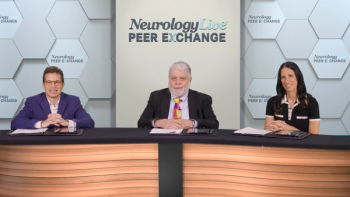
NeuroVoices: Jeffrey Cummings, MD, ScD, on Evaluating Alzheimer Trial Funding, Eliminating Wasteful Costs
The director of the Chambers-Grundy Center for Transformative Neuroscience at the University of Nevada–Las Vegas discussed his recently published research on the costs of developing treatments for Alzheimer disease.
To quantify the financial aspects of Alzheimer disease (AD) drug development in the private sector, investigators published research on the investment such research over the past 26 years. Over that time, the FDA approved only 5 novel drugs, all for symptomatic treatment only, with the most recent addition being aducanumab (Aduhelm; Biogen). Information collection on 1099 AD clinical trials during 1995 through June 2021 showed an estimated $42.5 billion in cumulative private expenditures in the research and development stage.
Despite the steady rise in expenditures, almost all the trials were considered failures. Of the 235 agents analyzed, 112 remain in active clinical development, 6 have reached commercialization, and 117 have had negative outcomes in various stages of clinical development—equating to a 95% failure rate. A closer look showed that 36 of these were late-stage failures, with 57% of the total cumulative private expenditures incurred during phase 3, the most of any phase.
Lead author Jeffrey Cummings, MD, ScD, has published numerous papers assessing the AD clinical pipeline as from a variety of different angles. Cummings, professor of brain science, and director, Chambers-Grundy Center for Transformative Neuroscience, University of Nevada–Las Vegas, sat down for a new iteration of NeuroVoices to discuss his most recent work in detail. He provided background on the reason for the analysis, how the clinician community should react to the data, and ways to eliminate drug failures.
NeurologyLive®: You’ve conducted assessments of the AD pipeline before, so what sparked your interest in cost?
Jeffrey Cummings, MD, ScD: We were so impressed that there had been a long line of failures that we began to wonder what the total cost of these failures was. Additionally, we wanted to know the total expenditure that pharmaceutical companies had made in drugs that had failed during this long period of time. I should mention we published a paper in February in the same journal on who funds Alzheimer disease drug development.
We realized that the number of trials over the last 5 years had stayed the same, but the number of NIH-funded trials over the last 5 years had gone up, and that could only mean that the other funders were coming down. That’s what prompted us to look into what the pharmaceutical side of things look like, as we examined the more global picture in the first of the 2 papers.
Are there parts of your results that surprised you? Did anything stand out?
I was shocked by the total costs. $42.5 billion had been invested in drug development between 1995, essentially when the last cholinesterase inhibitor was approved, to 2021, when aducanumab was approved. During that entire period, there was no drug approved by the FDA in the United States, and there was this enormous expenditure of $42.5 billion. The other thing that impressed me was the fact that there were 184,000 clinical trial participants during that period of time. Those are hours, days, weeks, and months that patients gave to drug development in the hope that new drugs would work. Of course, new drugs are emerging, with the success of aducanumab, but what looks like donanemab, gantenerumab, and lecanemab, which are all showing some promise.
Patients just made such an enormous contribution to drug development. There were 184,000 participants and each of them had a study partner. It’s twice that many people who made important contributions to drug development. Those are just normal people living out in the country. They’re the people we’re trying to help, but they’re also our allies in terms of drug development. That number—the size of it—was breathtaking to me.
How should clinicians and neurologists within the AD space interpret your data? What are the take-home messages?
The cost of individual drug development, which is around $5 billion to develop one drug. Neurologists and physicians in general should know that tremendous expense that goes into developing just 1 drug. That takes in that whole period from preclinical discovery and looking at animals to the final approval of an agent. It’s a lot of money to invest and develop a single agent.
But we have to have these drugs, right? This is an enormous public health problem, and we must find ways, particularly in delaying the onset of the illness. It’s going to be expensive, but no one said that saving the brain was also going to save money. We’re going to have to make some decisions in terms of what our priorities for expenditures are.
What encouraging signs or trends have you observed from drug development in recent years?
The success of monoclonal antibodies has been very impressive to me. All of the failures were small molecules, but all of the successes prior to aducanumab were also small molecules, cholinesterase inhibitors, and memantine. I’ve been impressed that the monoclonal antibodies have been the first to convincingly modify the pathophysiology of the disease itself.
We have biomarkers now, which are so informative. You can see the clearance of plaque in 6, 12, or 18 months, depending on when they do the scans. That’s been the remarkable thing. Although it’s not as much as we want, we’ve finally cracked the disease modification ceiling. We’re making progress on several drugs that have similar mechanisms of action.
Are there ways to eliminate drug failures? Should efficacy measures be reevaluated to ensure this?
One of the lessons of the paper was that the largest single expense in drug development was in phase 3. That accounted for 57% of the total expenditures in drug development. That means we should be stopping drugs in phase 2 more readily. Of course, pharmaceutical companies and drug developments have the same enthusiasm for stopping drugs as they do for stopping their children. They just don’t want to do it. There’s an enormous investment in it. They had some reason to believe in it, whether from animal data or some other basic science observation.
We need to be far more disciplined about stopping drugs. The biomarkers are going to be helpful. We have not had target engagement biomarkers that allow us to understand whether the drug was hitting the target. Now we do. If a drug is expected to lower plaques and doesn’t, it should be stopped. We should be more aggressive in terms of saying, “No, this is not shaping up the way we need it to be a successful drug.” That would have saved $21 billion if it had been done every time. Of course, you’re not going to do it every time, but we need to be far more disciplined than we have in saying, no this doesn’t look like a successful compound.
Transcript edited for clarity.
REFERENCE
Cummings JL, Goldman DP, Simmons-Stern NR, Ponton E. The costs of developing treatments for Alzheimer disease: a retrospective exploration. Alzheimer Dement. Published online September 28, 2021. doi:10.1002/alz.12450
Newsletter
Keep your finger on the pulse of neurology—subscribe to NeurologyLive for expert interviews, new data, and breakthrough treatment updates.





































